Sagaris
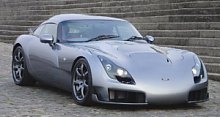 Imagine
if Tamora / T350C is equivalent to Porsche 911 Carrera, then Sagaris
will be 911 GT3 RS. In other words, it is far more hardcore than the
Tamora / T350C.
Although still suitable for road use, its main purpose is on race
tracks, where you will see the Sagaris goes and corners significantly
faster than Tamora and T350C. Imagine
if Tamora / T350C is equivalent to Porsche 911 Carrera, then Sagaris
will be 911 GT3 RS. In other words, it is far more hardcore than the
Tamora / T350C.
Although still suitable for road use, its main purpose is on race
tracks, where you will see the Sagaris goes and corners significantly
faster than Tamora and T350C.
The
racing purpose is first revealed in the exterior design.
Interestingly, the aggressive aerodynamic design looks like Sega game
icon Sonic mouse. It preserved the Tamora's compactness but added a
lot of wings and ventilation openings - the vents on the bonnet is to
enhance engine cooling, the holes on the flanks release the underbody
air pressure around the front wheels (just like many Le Mans cars).
In order to fit a driver wearing helmet, the roof at the driver's
side incorporates a dome. To increase downforce at the front, a pair
of aero flaps are added at the nose, in formula car style. To
increase downforce at the rear, a big gurney wing is added to the
tail. It is made of transparent perspex so that not to influence
rearward view. By the way, the Sagaris is the first TVR developed
with the help of wind tunnel.
Disregarding the aerodynamic kits, the Sagaris still looks sportier
than the Tamora / T350C on which it is based. This is because its
chassis is lower and wider than the original. In order to enhance
cornering stability, its tracks are widened by as much as 50 mm. On the
other hand, to lower center of gravity, the ride height is dropped by
25 mm - the lowest possible for a road car. Simultaneously, suspension
spring
rate is stiffened by 3 times (yes, 3 times !). The body is still made
of glassfiber while chassis
is still that backbone-type tubular steel frame, but a compulsory
roll cage increases chassis stiffness.
Surprisingly, the cockpit is by no means racing. Like other TVRs, it is
fully trimmed with leather, even including the roll cage ! The
dashboard has the same bespoke machined metal buttons as Tuscan. Only a
car fundamentally so light can afford such luxury.
 The
Sagaris has the standard 350 horsepower 3.6-litre Speed Six
replaced with the 4.0-litre version used in
the top Tuscan. With 12.2:1 compression, forged aluminum pistons and
forged steel con-rods, it produces 406 horsepower
and 349 lbft of torque. That makes it more powerful than Tuscan S and
only less than the 440-horsepower Tuscan R (T440R). Because the
Sagaris weighs just 1078 kg, it has a power to weight ratio higher
than Ferrari F430, Ford GT, 911 GT2 etc, though slightly less than
Noble M400 - another track-biased British sports car. The
Sagaris has the standard 350 horsepower 3.6-litre Speed Six
replaced with the 4.0-litre version used in
the top Tuscan. With 12.2:1 compression, forged aluminum pistons and
forged steel con-rods, it produces 406 horsepower
and 349 lbft of torque. That makes it more powerful than Tuscan S and
only less than the 440-horsepower Tuscan R (T440R). Because the
Sagaris weighs just 1078 kg, it has a power to weight ratio higher
than Ferrari F430, Ford GT, 911 GT2 etc, though slightly less than
Noble M400 - another track-biased British sports car.
The
big straight-6 is a two-edge sword - torquey from low to
mid-range and very powerful at the top end. It revs smoothly and
eagerly towards 7500 rpm, though accompany with a thunderous roar.
Throttle response is very sharp.
As
you can predict, Sagaris is lightening quick on the road, thanks to
the extraordinary combination of high power and lightweight. TVR
claims it take only 3.7 seconds to accelerate from rest to 60 mph and
then 8.1 seconds to 100 mph. Top speed is 185 mph. In fact, with so
little weight over the rear tires, it would be very difficult to find
sufficient traction to realize the claimed 0-60. It would have been
easier if it were mid-engined or rear-engined.
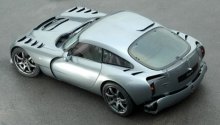 Anyway,
once the car is rolling, the acceleration is breathtaking. The car
feels light (it is) and responsive. A quicker-shifting 5-speed
gearbox and better positioned clutch and throttle pedals makes the
Sagaris more intimate to drive, as is the 2.0-turn, quick and
communicative steering. The enlarged brakes are powerful enough for
using in track days. Everything seems positive. Anyway,
once the car is rolling, the acceleration is breathtaking. The car
feels light (it is) and responsive. A quicker-shifting 5-speed
gearbox and better positioned clutch and throttle pedals makes the
Sagaris more intimate to drive, as is the 2.0-turn, quick and
communicative steering. The enlarged brakes are powerful enough for
using in track days. Everything seems positive.
The
wider track and stiffer suspensions give Sagaris much better body
control than Tamora and T350C, with so little pitch and roll. Yes, it
rides harsh on broken surfaces, but not to the extent that knocking
your eyeballs out, unlike many other race-purpose road cars. Moreover,
the stiff suspensions reduce front wheels movement, so the steering is
now less sensitive to road irregularities.
That means on British B-roads the Sagaris actually feels less nervous
and requires less
effort to drive.
However,
it is not to say the Sagaris easy to drive. Like Tamora, it has a
Hydratrak limited slip
differential between the rear wheels, but it is no way as advanced as
Ferrari's E-diff. If you apply too much throttle, the tremendous power
will light
up its rear tires and ruin the balance. This is a common problem for
all TVRs, or more
correctly speaking, a common problem for cars so light yet so
powerful, with an engine up front driving the rear wheels. But Sagaris
is definitely at the forefront of
this kind. To tame
it, you had to
learn how to modulate its throttle and steering smoothly.
Unquestionably,
the Sagaris is fun to drive, but it also requires respect from its
driver.
|
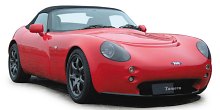 As
Chimaera is getting old and Rover V8 is running out, it is replaced by
Tamora. Like its predecessor, Tamora is designed to be the entry-level
car of TVR, that means cheaper, slower and easier to live with than
Tuscan
and Cerbera. However, for any car possesses 350 horespower and a kerb
weight
of 1050kg, we cannot call it slow, can we ? speed still means a lot to
TVR.
As
Chimaera is getting old and Rover V8 is running out, it is replaced by
Tamora. Like its predecessor, Tamora is designed to be the entry-level
car of TVR, that means cheaper, slower and easier to live with than
Tuscan
and Cerbera. However, for any car possesses 350 horespower and a kerb
weight
of 1050kg, we cannot call it slow, can we ? speed still means a lot to
TVR.
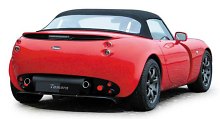 Tamora
also handles with more confidence than any other TVRs. Its suspension
setting
and choose of tyres hit the right balance between handling and ride
comfort.
Its revised steering geometry is less nervous and aggressive as Tuscan
at turn-in. Its calmer engine is less prone to oversteer the car, so
the
tail is better tie down to ground. Although it will never be developed
to be as fool-proof as Porsche Boxster, it is still enjoyable to drive
in daily basis. The controls are not as well tuned as the Porsche. The
balance and brakes are also not there yet. But adding performance
factor
into the equation and it is not crazy to choose the TVR over Boxster S,
even though they are close in price. Before the Boxster get more power,
many sports car enthusiasts will see the baby TVR as the most fun to
drive
in class.
Tamora
also handles with more confidence than any other TVRs. Its suspension
setting
and choose of tyres hit the right balance between handling and ride
comfort.
Its revised steering geometry is less nervous and aggressive as Tuscan
at turn-in. Its calmer engine is less prone to oversteer the car, so
the
tail is better tie down to ground. Although it will never be developed
to be as fool-proof as Porsche Boxster, it is still enjoyable to drive
in daily basis. The controls are not as well tuned as the Porsche. The
balance and brakes are also not there yet. But adding performance
factor
into the equation and it is not crazy to choose the TVR over Boxster S,
even though they are close in price. Before the Boxster get more power,
many sports car enthusiasts will see the baby TVR as the most fun to
drive
in class. 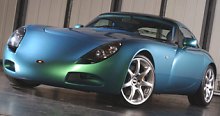
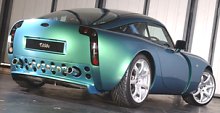
 Imagine
if Tamora / T350C is equivalent to Porsche 911 Carrera, then Sagaris
will be 911 GT3 RS. In other words, it is far more hardcore than the
Tamora / T350C.
Although still suitable for road use, its main purpose is on race
tracks, where you will see the Sagaris goes and corners significantly
faster than Tamora and T350C.
Imagine
if Tamora / T350C is equivalent to Porsche 911 Carrera, then Sagaris
will be 911 GT3 RS. In other words, it is far more hardcore than the
Tamora / T350C.
Although still suitable for road use, its main purpose is on race
tracks, where you will see the Sagaris goes and corners significantly
faster than Tamora and T350C.  The
Sagaris has the standard 350 horsepower 3.6-litre Speed Six
replaced with the 4.0-litre version used in
the top Tuscan. With 12.2:1 compression, forged aluminum pistons and
forged steel con-rods, it produces 406 horsepower
and 349 lbft of torque. That makes it more powerful than Tuscan S and
only less than the 440-horsepower Tuscan R (T440R). Because the
Sagaris weighs just 1078 kg, it has a power to weight ratio higher
than Ferrari F430, Ford GT, 911 GT2 etc, though slightly less than
Noble M400 - another track-biased British sports car.
The
Sagaris has the standard 350 horsepower 3.6-litre Speed Six
replaced with the 4.0-litre version used in
the top Tuscan. With 12.2:1 compression, forged aluminum pistons and
forged steel con-rods, it produces 406 horsepower
and 349 lbft of torque. That makes it more powerful than Tuscan S and
only less than the 440-horsepower Tuscan R (T440R). Because the
Sagaris weighs just 1078 kg, it has a power to weight ratio higher
than Ferrari F430, Ford GT, 911 GT2 etc, though slightly less than
Noble M400 - another track-biased British sports car.  Anyway,
once the car is rolling, the acceleration is breathtaking. The car
feels light (it is) and responsive. A quicker-shifting 5-speed
gearbox and better positioned clutch and throttle pedals makes the
Sagaris more intimate to drive, as is the 2.0-turn, quick and
communicative steering. The enlarged brakes are powerful enough for
using in track days. Everything seems positive.
Anyway,
once the car is rolling, the acceleration is breathtaking. The car
feels light (it is) and responsive. A quicker-shifting 5-speed
gearbox and better positioned clutch and throttle pedals makes the
Sagaris more intimate to drive, as is the 2.0-turn, quick and
communicative steering. The enlarged brakes are powerful enough for
using in track days. Everything seems positive.